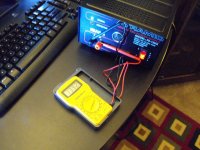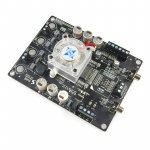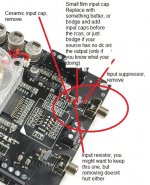OK now, so after numerous Zep Pressure Tests it would appear that this Amp wants more than 3A. It tries to draw more than that from the HP P/S and causes the Adapter to go into momentary Shutdown..That in turn causes the Sure Amp to go into Under-Voltage Protection Shutdown. But, even so, at 3A it will still play 'Neighbor Annoyingly' Loud..
Novice alert!
Hi guys
Been browsing this thread for a while now, as a little while ago I bought one of the TK2050 amps from Sure on ebay. So far, I'm absolutely loving it. That said, I am having a few issues with it. I've done my best to read the entirety of this thread (which I'm blown away by, what with the amount of knowledge here!), but I have no doubt missed nuggets of vital information somewhere!
I'm having two issues currently, which are as follows:
When ever I use any audio source that is grounded via the mains, I get a really rather loud hiss through the speakers. My PC and Laptop (when on charge) are just two examples. However, when I use a source that isn't grounded, like an MP3 player, or my laptop when on battery power, the hiss disappears completely. Now, currently I'm using a Dell laptop SMPS as my power supply for the amp. Having read this thread, it seems that meanwell power supplies are the way forward, so I have ordered a new PSU. My question on this front is, is it most likely that a poor quality SMPS is the cause of the hissing?
Secondly, I have wired in a 10K log Pot into the audio cable, which upon testing it makes hardly any difference to the volume. Have I grossly under estimated the value of the Pot I need? Or have I simply not wired it into the correct place?!
I'd very much appreciate any advice people can offer! Once I'm a bit more confident with soldering, I'll then start looking at changing components on the board.
Many thanks in advance
Woody
Hi guys
Been browsing this thread for a while now, as a little while ago I bought one of the TK2050 amps from Sure on ebay. So far, I'm absolutely loving it. That said, I am having a few issues with it. I've done my best to read the entirety of this thread (which I'm blown away by, what with the amount of knowledge here!), but I have no doubt missed nuggets of vital information somewhere!
I'm having two issues currently, which are as follows:
When ever I use any audio source that is grounded via the mains, I get a really rather loud hiss through the speakers. My PC and Laptop (when on charge) are just two examples. However, when I use a source that isn't grounded, like an MP3 player, or my laptop when on battery power, the hiss disappears completely. Now, currently I'm using a Dell laptop SMPS as my power supply for the amp. Having read this thread, it seems that meanwell power supplies are the way forward, so I have ordered a new PSU. My question on this front is, is it most likely that a poor quality SMPS is the cause of the hissing?
Secondly, I have wired in a 10K log Pot into the audio cable, which upon testing it makes hardly any difference to the volume. Have I grossly under estimated the value of the Pot I need? Or have I simply not wired it into the correct place?!
I'd very much appreciate any advice people can offer! Once I'm a bit more confident with soldering, I'll then start looking at changing components on the board.
Many thanks in advance
Woody
The noise from PC sources (with mains power connected) is very common. This isn't a fault with your amp, just a grounding issue. I recently built a small gainclone for use with my PC at work, and installed 1:1 transformers on the inputs to isolate the amp signal ground. Worked a treat - no noise at all.
Your volume pot can't be installed correctly. Any volume pot, 1Kohm to 1Mohm, log or linear will still cover the range of silence to full volume when installed correctly. Check the in, out and ground are connected correctly. Good luck!
Your volume pot can't be installed correctly. Any volume pot, 1Kohm to 1Mohm, log or linear will still cover the range of silence to full volume when installed correctly. Check the in, out and ground are connected correctly. Good luck!
Many thanks for the replies 
So is it at all possible that a better PSU will lessen the issue? Or is it literally a case of the only solution being isolating the two from each other?
I'm not too fussed if the new PSU makes no difference, as I recall reading that a higher voltage PSU can make for a better sound?
Just to clarify... the 1:1 transformers you installed, was that in the amp signal ground only? You didn't isolate the signal path either? Sorry for the 20 questions, Just want to fully understand is all
Thanks also for clearing up the Pot issue, I'll have a fiddle around with that. Would I be correct in assuming the pot is to attenuate the actual signal only? The ground wires can be connected directly, bypassing the pot entirely?
Thanks again
So is it at all possible that a better PSU will lessen the issue? Or is it literally a case of the only solution being isolating the two from each other?
I'm not too fussed if the new PSU makes no difference, as I recall reading that a higher voltage PSU can make for a better sound?
Just to clarify... the 1:1 transformers you installed, was that in the amp signal ground only? You didn't isolate the signal path either? Sorry for the 20 questions, Just want to fully understand is all
Thanks also for clearing up the Pot issue, I'll have a fiddle around with that. Would I be correct in assuming the pot is to attenuate the actual signal only? The ground wires can be connected directly, bypassing the pot entirely?
Thanks again
Last edited:
The 1:1 transformers have a primary coil that is connected to both the signal in and ground connections coming from the PC, and a secondary coil that provides a signal out and ground (that is isolated from the PC ground). I used cheap Monacor LTR-110 transformers, with signal in connected to pin 3, PC ground to pin 1, signal out to pin 8 and ground out to pin 6 (see http://www.monacor.dk/produkter/proflyd-linedriver/vnr/210500/?type=257&no_cache=1). These aren't as good sounding as better transformers from Jensen, Lundahl, Sowter, UTC etc. but will provide the ground isolation you require.
Another (better) way of isolating the noisy ground of a PC is to use a USB to optical s/pdif converter, then connect this to a dac. The optical link separates the grounds perfectly. With good USB converter and dac, this approach will probably be much better than taking line level audio direct from the PC sound card.
You are right that the pot is there to attenuate the incoming signal, but the ground must be connected to the pot to allow the pot to behave as a voltage divider. Normally signal in goes to one of the outside pins, ground the other outside pin and signal out the middle pin on a potentiometer. Try this and measure the resitances as per my last post.
Another (better) way of isolating the noisy ground of a PC is to use a USB to optical s/pdif converter, then connect this to a dac. The optical link separates the grounds perfectly. With good USB converter and dac, this approach will probably be much better than taking line level audio direct from the PC sound card.
You are right that the pot is there to attenuate the incoming signal, but the ground must be connected to the pot to allow the pot to behave as a voltage divider. Normally signal in goes to one of the outside pins, ground the other outside pin and signal out the middle pin on a potentiometer. Try this and measure the resitances as per my last post.
I've been looking into the different options you recommended sharpi. I've found those transformers you mentioned, and can get two for ~£24 delivered. Certainly an amount I'm prepared to pay to solve the problem!
Alternatively, so fulfill your other recommendation... would THIS suffice do you recon?
Alternatively, so fulfill your other recommendation... would THIS suffice do you recon?
AA-AB32181 Mods Page
I have just received several of my AA-AB32181 boards from Parts-Express.
After reading 150 of the posts in this thread, I was wondering if their was any threads or information on modding this new board.
Things have changed a bit from the orignal board and I feel like I'm starting over.
Any advice would be appreciated. Mainly interested in replacing the input caps and the output coils, if needed.
Thanks,
Allen...
I have just received several of my AA-AB32181 boards from Parts-Express.
After reading 150 of the posts in this thread, I was wondering if their was any threads or information on modding this new board.
Things have changed a bit from the orignal board and I feel like I'm starting over.
Any advice would be appreciated. Mainly interested in replacing the input caps and the output coils, if needed.
Thanks,
Allen...

Input caps
Everything I would recommend is still the same. The new boards come with 10uH coils which might sound better than the 22uH that we were removing. Dayton foil input caps at 1.5 - 3.5uf would be great. Parallel the .47 caps to make the value. I also run foil filter caps but have never compared them to the stock caps having always done the coils and caps together. Does the fan run since they now have temp control? Do you hear it in the music?I have just received several of my AA-AB32181 boards from Parts-Express.
After reading 150 of the posts in this thread, I was wondering if their was any threads or information on modding this new board.
Things have changed a bit from the orignal board and I feel like I'm starting over.
Any advice would be appreciated. Mainly interested in replacing the input caps and the output coils, if needed.
Thanks,
Allen...
Everything I would recommend is still the same. The new boards come with 10uH coils which might sound better than the 22uH that we were removing. Dayton foil input caps at 1.5 - 3.5uf would be great. Parallel the .47 caps to make the value. I also run foil filter caps but have never compared them to the stock caps having always done the coils and caps together. Does the fan run since they now have temp control? Do you hear it in the music?
My first experience was that this amp is noisy. I had it hooked to my computer and I used the stock PS from my Virtue Audio amp. It's 24 volt PS.
I heard a low pitched noise out of my speakers. Then, after a few minutes, I heard a high pitch whine and notice the fan was trying to spin up. If I helped it spin up, it would run for about 30 seconds and cut off, and the high pitch whine went away. If I didn't help it, the fan would eventually spin up. I think using a well designed heat sink is the way to go. I'll be studying the previous posts to figure out what I'm going to do their.
What about the components that need to removed or bridged. Which ones are they now?
My goal is to replace the input caps, the coils, and possibly the tank caps.
I have a 50k Alps blue velvet and some 2.2uF Auricaps lying around. I was going to start with those. Then I will try the Wurths, as everyone seems to like them.
So, can someone tell me what the components are on the new version of the board that need to be removed or bridged?
Also any recommendation on the Zobel would be appreciated.
Thanks,
Allen...
Remove the suppressor (diode like) things underneath the input of the board (if they are still present there)
Also: Post some high res pics
I will take some pictures and post. I didn't see anything under the board.
I've attached a page from the new manual which shows the board layout.
What do you make of this?
Attachments
Last edited:
Digikey
Digikey is out of stock on the 4.7. You can use the 3.5uH.
.
Digi-Key - 732-1238-1-ND (Manufacturer - 7447709003)
.
Hi,
I'm about to buy some Wuerth XLL coils from Newark. They order them from Farnell in the UK and want an extra $20 for shipping.
Does anyone know a good source for these in the US? I've searched this thread and can't find one yet.
Thanks -- Mush
Digikey is out of stock on the 4.7. You can use the 3.5uH.
.
Digi-Key - 732-1238-1-ND (Manufacturer - 7447709003)
.
Mods for New Board
Scott,
I agree with using the same upgrades. Since this board is different from the original, can you tell me from the picture which resistors need to be removed and which caps need to be bridged if I'm going to add new input caps?
Also, a few years ago, Auricaps seem to be all the rage. I haven't heard to many people mention them here. Is it because they're not as good as everyone once thought, or just to expensive?
Thanks,
Everything I would recommend is still the same. The new boards come with 10uH coils which might sound better than the 22uH that we were removing. Dayton foil input caps at 1.5 - 3.5uf would be great. Parallel the .47 caps to make the value. I also run foil filter caps but have never compared them to the stock caps having always done the coils and caps together. Does the fan run since they now have temp control? Do you hear it in the music?
Scott,
I agree with using the same upgrades. Since this board is different from the original, can you tell me from the picture which resistors need to be removed and which caps need to be bridged if I'm going to add new input caps?
Also, a few years ago, Auricaps seem to be all the rage. I haven't heard to many people mention them here. Is it because they're not as good as everyone once thought, or just to expensive?
Thanks,
Attachments
Attached some drawing of the board
Do the same for the other channel
The film cap can be bridged or replaced. If bridged, make sure your source has NO DC ON THE OUTPUT, it will fry the amp. If your source HAS dc, and you still want to bridge it, add some caps at the rcas (take a look at audio1sts drawing)
Do the same for the other channel
The film cap can be bridged or replaced. If bridged, make sure your source has NO DC ON THE OUTPUT, it will fry the amp. If your source HAS dc, and you still want to bridge it, add some caps at the rcas (take a look at audio1sts drawing)
Attachments
So, I figured out the P/S ShutDown Problem...The Amp does indeed want more from the P/S...So, I just screwed a Nippon 50v 2900uF Cap across the Power Inputs. Now the Board will Easily cross that Line between Way Too Loud, and Distortion...I now find myself having to turn it down..It seems Too Easy a Fix..
It just passed the 'Zep Test' and I'm expecting to either see Smoke, or have a Knock on the Door...
It just passed the 'Zep Test' and I'm expecting to either see Smoke, or have a Knock on the Door...
remove input resistor
The text in the drawing is not quite right. If you bridge the stock cap and use your new cap in a different location than the stock one, such as on the way from a case mounted rca to the board, you must remove the input resistor or else you will be shorting the 2.5v dc bias that sets the output offset trim. You may install a different input terminating resistor before the cap or just leave it out. My dac sounded better with a 20k terminating resistor.Attached some drawing of the board
Do the same for the other channel
The film cap can be bridged or replaced. If bridged, make sure your source has NO DC ON THE OUTPUT, it will fry the amp. If your source HAS dc, and you still want to bridge it, add some caps at the rcas (take a look at audio1sts drawing)
- Status
- This old topic is closed. If you want to reopen this topic, contact a moderator using the "Report Post" button.
- Home
- Amplifiers
- Class D
- Sure Electronics New Tripath Board tc2000+tp2050


